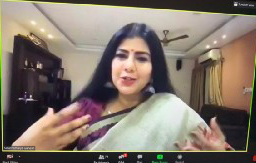“Imagine the evolution of the Margam as a sticky ball,” began Dr Swarnamalya Ganesh, in a tight, well-informed lecture titled The Evolution of the Margam that attempted to focus on the notion of the past, and its fantastic ability to move forward, including along the way a slew of eclectic influences, inspirations and imagination, “Now think of that ball,” she said, “as one that rolls and picks up things along the way; where and when exactly did the ball roll, who really rolled it forward, how many people actually picked it up…What all did they pick up from it and what all did it pick up as it rolled by — languages, cultures, several histories, multiple visions and imaginations.”
The metaphor of the ball is particularly crucial and interesting in the context of the Margam for it establishes the imperativeness of the Margam, as Swarnamalya said, as a living, breathing, moving and dynamic entity that doesn’t remain, trapped in a time and an era but one that travels through the course of human history and acquiring nuances in the hands and heads of artistes who decide to add their personal dimensions to it.

The solo dancer, Swarnamalya said, in the context of Bharatanatyam, continues to be obsessed, in a sense, of acquiring the Margam. “One she/he learns a Margam, she/he, shifts focus to acquire and learn another. The evolution of the Margam is a journey of human transfer and the very fact that we agree that the Margam is in a process of evolution is testimony that it is an entity with a constant ebb and flow.
Swarnamalya’s lecture also focussed on the importance of using words and understanding culture and context, with caution. Tracing back to the 16th century, a period that informed students of human history have access to, Swarnamalya made references to what constituted the structure of what we refer to now as the Margam but was originally created or “culled” as she said by the famous Thanjavur Quartette.
The Sadir kutcheri that the Tanjore Quartette performed that we now call the Margam included a repertoire that has undergone shifts and changes, aplenty. The Pre Thanjavur Quartette dances for instance, included dances like the Mukhachali which was similar to the Alarippu but like the Alaru had a dramatic, theatrical entry of sorts. What has also undergone shifts, she said, is the notion of not merely the repertoire but also the stance of the dance itself.
For young dancers, it is important to appreciate that the waterterype Margam that we know now, is in itself a story of evolution and that with literature, culture and changing histories. And in its very scope it is meant to expand and assimilate and yet remain inclusive. “The Margam is both an outward and an inward movement.”
This session was hosted by Sreedevi Sivarajasingam of Apsaras Arts.
Up next
Re-imagining the Solo by Malavika Sarukkai









